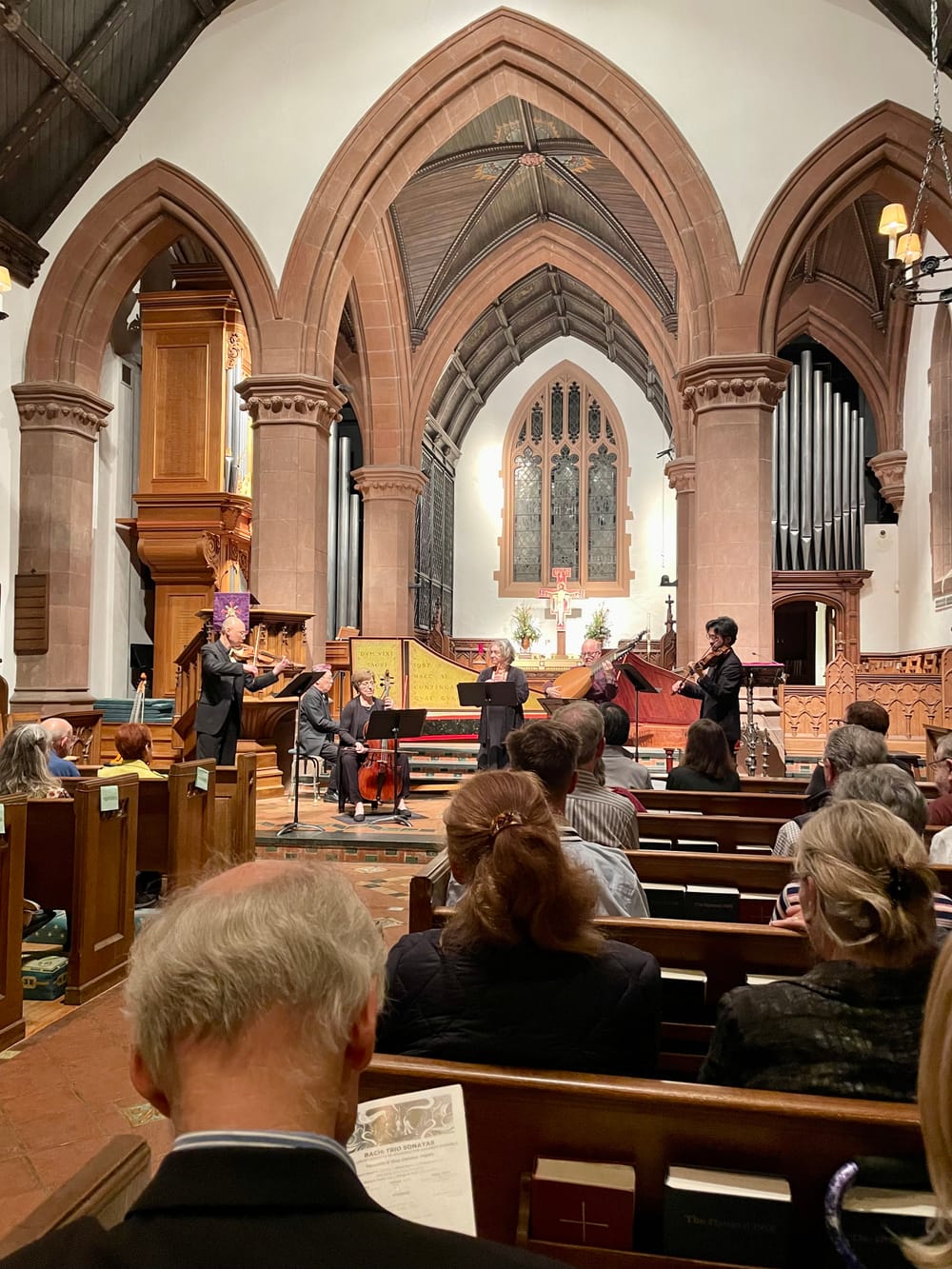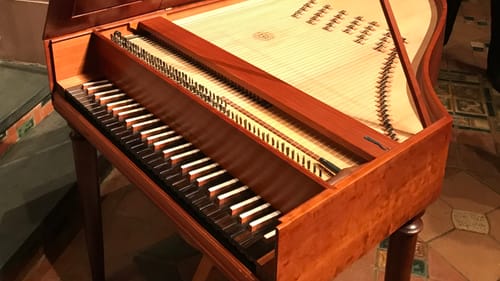Stay in the Loop
BSR publishes on a weekly schedule, with an email newsletter every Wednesday and Thursday morning. There’s no paywall, and subscribing is always free.
Rearranging the Organ Sonatas—just like Bach used to do
Tempesta di Mare presents Bach’s Trio Sonatas

Given the musical status of Johann Sebastian Bach, it might seem daunting to consider his seminal works in a new light. But the redoubtable ensemble Tempesta di Mare, Philadelphia’s noted baroque orchestra, has successfully done just that.
Bach himself often re-purposed, re-arranged, or re-used his own works, and so Tempesta co-directors Richard Stone and Gwyn Roberts decided—in accordance with Bach’s own practice—to reconfigure six of his iconic keyboard works, often called the Organ Sonatas. This suite, catalogued as BWV 525-530, has come down in two manuscripts, one in Bach’s own hand and one likely copied by his son Wilhelm Friedemann.
The three-part pieces were written to be played on two keyboards and pedals (the organ’s configuration), with two melodic parts and one accompanying bass line. But because these pieces feature such distinctive melodies, Tempesta felt that they would lend themselves to chamber music arrangements, and indeed they did.
The works were adapted for six musicians drawn from the group’s larger orchestra: Roberts (recorder), Emlyn Ngai and Francis Liu (violins), Lisa Terry (cello/viola da gamba), Stone (lute), and Dongsok Shin (harpsichord), in this live concert that recreated Tempesta’s well-received 2014 Chandos recording.
Variety, surprise, and aplomb
For this concert, the sonatas were grouped in two sections of three, separated by an intermission. Some were changed from their original keys to accommodate this differing instrumentation, raising concerns (swiftly allayed) from organists in the audience for whom these are repertoire staples. All six works have a similar structure: lively outer sections separated by a slower middle movement. Tempesta set each sonata with a different instrumental grouping, a decision that created an evening of both variety and surprise.
The concert began and ended with two works featuring all six musicians. BWV 529 (the first offering)—a work filled with verve and forward motion—opened with lively alto recorder passages, eloquently played by Roberts. The concert’s closer was BWV 530, and its two lively movements (Vivace and Allegro) also featured Roberts in one of the evening’s highlights: virtuosic extended soloistic recorder passages played with seeming ease (though certainly not easy!) and great aplomb.
Third on the program (just before intermission) was BWV 525, arranged for five of the six musicians (Liu sat out this one). Its second movement had elegant lines for recorder and violin (Ngai, Tempesta’s concertmaster and an elegant stylist). The third (Allegro) section featured especially robust lines for the cello, which Terry delivered with a verve and delineation that made it possible to follow the instrument’s unusually melodic line.
Revamped for virtuosos
The evening’s second half began with BWV 527, set for recorder, viola da gamba (the cellist switched instruments here), and harpsichord, a duet for Roberts and Terry buoyed by Shin’s consistently elegant continuo. Of interest, Bach repurposed this work’s second (Adagio e dolce) movement in his Triple Concerto in A minor (BWV 1044), there set for flute and violin.
Next to last on the program was BWV 526, arranged for duo violins as soloists (with lute and harpsichord continuo), performed here in D minor from the original key of C minor to accentuate the brilliance and virtuosity of violinists Ngai and Liu. Several times, including here, an unresolved harmonic phrase carried the music directly into the next movement.
Meet the lautenwerck
But a concert highlight came near the beginning. The evening’s second piece (BWV 528) was set as a duet for lute and harpsichord. But there was a surprise substitution. Sitting beside Shin’s beautiful harpsichord (which he played for most of the evening) was a much smaller keyboard instrument, unfamiliar to most in the audience. Calling it his “mini-me harpsichord”, Shin introduced the lautenwerck.

Dating back as early as 1511, the lautenwerck (like a lute) is strung with gut strings, and it sounds remarkably lute-like. Since Bach himself owned two of these, Shin felt that “it might be fun” to surprise the audience with this unusual instrument. No historical examples survive today, only written descriptions, so each contemporary re-creation is a combination of the maker’s research and interpretation. Shin’s lovely instrument was crafted by Anden Houben, a harpsichord builder in Tuscaloosa, Alabama.
This work’s middle (Andante) movement was especially beautiful, and these graceful instruments (sometimes sonically eclipsed by more prominent baroque forces) were here heard with perfect clarity. Well-matched, Stone and Shin traded off eloquent phrases (like riffs in jazz) that highlighted both the similarities and differences in their two instruments. The church’s acoustics were perfect for this delicate arrangement, and the rhythmic parallel passages in the third (Un poco allegro) section were especially resonant.
A new cast of characters
Throughout this unusual concert, detailed program notes by Stone and Roberts helped enormously in threading through the details of their complex presentational concept. Tempesta’s goal was to treat these works as “conversational chamber music”, and they succeeded admirably. In an online pre-concert blog, Stone said, “The beauty of playing this all as chamber music is that six monologues for a solo instrument become dialogues among a cast of distinct characters.” And Roberts cited them as “little masterpieces, compact and vibrant”. That’s also a description of this concert, an intriguing and unusual evening that was (as always with Tempesta) executed with joy, excellence, and elan.
At top: Tempesta di Mare in concert at Christ Church Christiana Hundred on April 4, 2025. (Photograph by Cameron J.S. Kuzepski.)
What, When, Where
Bach Trio Sonatas. By Johann Sebastian Bach. Tempesta di Mare Chamber Ensemble: Gwyn Roberts (recorder), Emlyn Ngai and Francis Liu (violins), Lisa Terry (cello/viola da gamba), Richard Stone (lute), and| Dongsok Shin (harpsichord/lautenwerck). April 4, 2025 at Christ Church Christiana Hundred, Wilmington. (215) 755-8776 or tempestadimare.org
Accessibility
Christ Church Christiana Hundred is a wheelchair-accessible venue, with free onsite parking. The concert was also presented in Philadelphia and Chestnut Hill.
Sign up for our newsletter
All of the week's new articles, all in one place. Sign up for the free weekly BSR newsletters, and don't miss a conversation.

 Gail Obenreder
Gail Obenreder